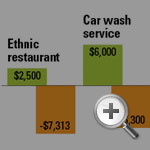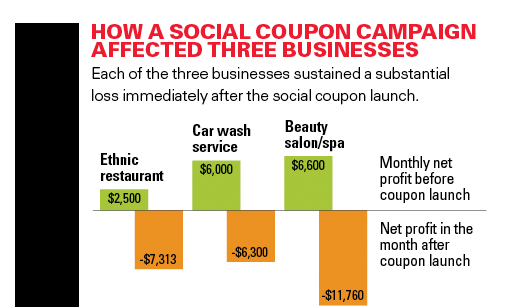The Perils of Social Coupon Campaigns
To achieve benefits from social coupons, businesses should design deals carefully — without giving too much away.
Topics
Social Business

Although most customers buy social coupons for a specific purpose, there may be some opportunities to broaden the relationship.
Social coupons have become a popular form of marketing promotion. On any given day, scores of businesses such as restaurants, car washes and dry cleaners pitch coupon discounts through Internet sites such as Groupon and LivingSocial in hopes of attracting a new crop of customers. But a poorly designed coupon campaign can do serious harm to a business’s profit margin. While the coupons can generate value for customers and the social coupon service providers themselves (who earn a percentage of the revenue), they can lead businesses into a thicket of problems.
We explored the impact of social coupon campaigns on three locally oriented businesses located in a southeastern city in the United States: an ethnic restaurant that normally earned $2,500 in net profit per month; a car wash service that normally earned $6,000 per month; and a beauty salon/spa that normally earned $6,600 per month. We tracked these businesses for one year following their coupon launches, providing us with information on several business variables, including the revenue trend and acquisition and retention rates. Based on this data, we developed business models to project how the coupon campaigns would affect both short-term and long-term performance. (The detailed results of our study were reported in the January 2012 issue of the Journal of the Academy of Marketing Science. See “Related Research.”) Our goal was to determine the extent to which coupon initiatives could lead to an increase in profits, the factors that work for and against the businesses acquiring and retaining customers, and the opportunities for program design changes (including revamping the coupon’s discount percentage and the rules regarding existing customers) that could be used to improve profitability. We also studied the potential for up-selling and cross-selling initiatives that could improve profitability.
What We Found
In their current form, social coupons are not ideally suited to ensure customer acquisition and yield business profits. Although all three of the businesses we studied captured significant numbers of new customers with their coupon offers, each saw substantial losses during the month the coupon campaigns were launched, which in turn created significant financial burdens. In the case of the restaurant, the loss in the first month was more than $7,000; for the car wash service, it was $6,300, and for the spa it was $11,760. (See “How a Social Coupon Campaign Affected Three Businesses.”) Such losses would not have been so serious if the businesses were able to achieve higher revenues and increased profits in future months. However, this was not the case. Despite their best marketing efforts, the three businesses had difficulty retaining most of the new customers who were attracted to the coupon offers. Based on our analysis, it will take the car wash service and ethnic restaurant 15 and 18 months, respectively, to recover from the profit shortfall following the coupon launch; for the beauty salon and spa, the recovery period for the coupon campaign at current business levels was projected at more than 98 months, or eight years. Needless to say, extended recovery periods discourage businesses from initiating new coupon launches. Businesses that want to prevent social coupons from cannibalizing profits need to design their deals carefully so they aren’t giving too much away.
Avoiding the Pitfalls
Businesses considering social coupon campaigns should make an effort to understand how and why coupons work, and how they can affect the economics of the business both in the short term and in the long term. We have developed some general guidelines that can help businesses identify and avoid the pitfalls of social coupon campaigns.
Use coupons to build broad relationships with new customers. Businesses typically think of social coupon launches in terms of adding new customers. But at the three businesses we studied, the impact of new customers was decidedly mixed. Every new customer visiting the restaurant with the coupon resulted in a $14 decline in profits; for the car wash, the decline was $17; for the beauty salon, $39. One way for companies to mitigate such potential losses is to see customer visits as opportunities to up-sell or cross-sell other products or services. Although most customers buy coupons for a specific purpose and redeem them for particular products, there may be some opportunities to broaden the relationship. For example, a roofing contractor can try to cross-sell its gutter installation and cleaning services, and a massage studio can try to cross-sell health and wellness products. As much as possible, the decision to launch a social coupon campaign should be viewed as part of a broader business strategy rather than as a specific marketing tactic.
Related Research
V. Kumar and B. Rajan, “Social Coupons as a Marketing Strategy: A Multifaceted Perspective,” Journal of the Academy of Marketing Science 40, no. 1 (2012): 120-136.
Be strategic about offering discounts. Customers purchase social coupons for their deep discounts. While the low price is an incentive for new customers to try out the product or service offering, many will expect to pay the same low price later on; in a competitive market, any price increase may be viewed as a reason to take their business elsewhere. There is a segment of consumers who buy items only when they are discounted, which obviously undermines profits.
Against this backdrop, businesses should think twice about how social coupons are designed and how the discount will be structured. Depending on what is feasible and practical, a business might decide to limit the number of coupons offered, restrict which categories of customers are eligible to use them (for example, only new customers) or offer a more modest discount rate. For example, following its initial coupon campaign, the ethnic restaurant we examined decided to experiment with a less generous offer. The new coupon was only good on Tuesdays and Wednesdays, their slowest days of the week; the discount was reduced to 30% from 50%; and a minimum purchase was required to make use of the offer. The early results of the second campaign have been promising: Losses in the month after the coupon launch decreased to almost zero (compared with the earlier loss of more than $7,300 in that month).
Guard against cannibalizing existing revenue. Given that the primary motive of launching a social coupon is to attract new customers, most businesses wouldn’t ordinarily want to encourage their existing customers to use discount coupons. Making coupons available to people currently paying full price damages profitability and encourages deal-seeking behavior.
One way to address this problem — and protect profit levels — is to provide social coupons to new customers only. When businesses restrict offers to new prospects, the chances of improving profitability are greatly increased. None of the three businesses we studied anticipated the negative impact of offering coupons to existing customers. As they saw it, with more customers signing up for the coupon, they would only benefit from the increased customer visits. However, we found that less can be more: A 1% reduction in the number of existing customers receiving coupons trimmed the beauty salon’s profit shortfall by $495; for the restaurant, the 1% reduction was worth $187; for the cash wash service, $224.
By changing the nature of the coupon deals, businesses can better control the number of new customers visiting them, the effect on profit margins of the discounted purchases and the number of existing customers taking advantage of the offer. How campaigns are calibrated can have tremendous implications for revenues and profits, both in the short term and over extended periods of time. Typically, the network effects of group buying are considered desirable. But unless managers are careful about how coupon programs are designed, network effects can become a negative force.



Comments (9)
Harry Jacob
Do Mobile Coupons Work Well For Car Wash Businesses?
Intrigued Reader
notxin
dimanise
mjbhatti
fatsgrill
tlfogarty
KathyMcCurry